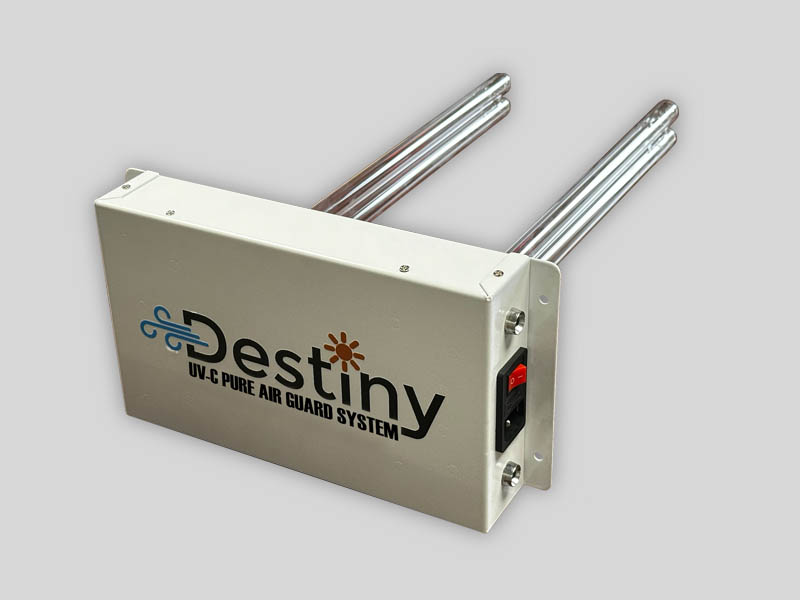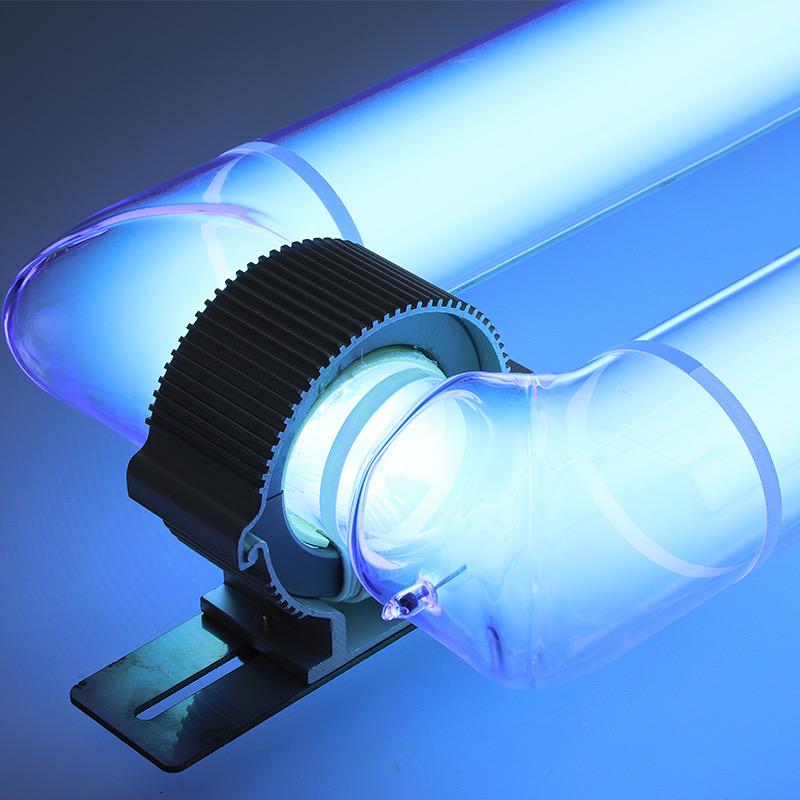
MEET THE
DESTINY UV-C PURE AIR GUARD SYSTEM
PURE AIR CONTROL SYSTEM
An unrivaled UV-C air-treatment system for residential and light commercial settings, compatible with all HVAC units, including heat pumps.

THE ISSUE
Our homes are our refuge. Typical residential HVAC systems do not protect us from airborne pollutants or disease, and in fact, only work to spread those contaminants throughout our entire household, creating an unsafe and unhealthy environment. Families are left completely exposed to harmful and infectious airborne impurities, causing prolonged sickness and distress. Loved ones with compromised immunities along with global epidemics are proof that resolution must be secured.
THE SOLUTION
With our extraordinary system, not only is the air we breathe disinfected and sanitized using dual UV-C lights unwanted odors are also removed. This unique system produces circulated air that is now clean and purified, difference that will be immediately recognized by everyone. This technology greatly assists in keeping our families and pets healthy and comfortable, allowing us to focus on other important items, including those holiday parties and bedtime stories. The UV-C Pure Air Guard System really is the peace of mind we’ve been searching for.
THE FEATURES
-
UV-C dual bulb system
-
Coverage 4,000 SQFT
-
70,000 Hrs. of life use
-
Bulbs easily replaced
-
Direct power or low voltage connections
-
Sterilization rate of 99.9%
-
For Residential or light commercial areas
-
Can daisy-chain multiple systems
-
Capability to work with all units including heat pumps
-
Removes all odor from area including not limited to pet, airborne pollutants, and disease
-
Improves indoor air quality while being economical and energy efficient
-
Sterilization rate of 99.9%
-
Made in the U.S.A.


On average, UV-C slashes 10% to 25% of HVAC energy use

The PLC (Programmable Logic Controller) connects with a series of sensors mounted inside the HVAC unit plenum such as
CO2
UV-C
Temperature
Humidity
Airflow
YOU ARE DESTINED TO BREATHE CLEAN AIR, TRY DESTINY PURE AIR SYSTEM
DESTINY PURE AIR SYSTEM IS PERFECT FOR:
Private Homes
Town Homes
Light Commercial
Light Industrial
Private Medical Offices
Dental & Chiro

Spas & Salons
Gyms & Yoga Studios
UV-C systems provide three levels of benefits when applied to HVAC systems.
LEVEL 1
HVAC System Efficiency
LEVEL 2
Indoor Air Quality
UV-C improves airflow levels and eliminates organic material on surfaces, which helps improve indoor air quality (IAQ) by reducing pathogens and odors. This improves occupant productivity, boosts comfort levels, and reduces sick time.
LEVEL 3
The easy & effective way to purify your building’s air.

How It Works
The Destiny Pure bulbs produce a UV-C light that sterilizes the passing air with a disinfecting light. The UV-C bulbs break down organic matter killing bacteria, mold, and airborne diseases like COVID. Enclosed safely in your air handling system the light turns on as the air passes. Our unique cortisol system is designed to work with all HVAC systems and make it easy to add to any existing system.
Destiny Pure system will filter effectively and will kill any of the harmful particles in the air. With your recycled air now clean, it will lower your need to bring in fresh air. Less need for outside air will reduce your energy cost, the frequency of needing to replace costly filters, and even the need for large ductwork for high-volume fresh air exchange.
The ultraviolet light sterilizes the airflow to eliminate bacteria and viruses. Special reflectors increase the UV intensity and improve the efficiency of disinfection. The disinfected air circulates back to space. The UV light source of the air sterilizer is in a light-enclosed space, therefore, there are no threats to people and pets; just clean, safe air.
Benefits of Our UV-C System
- Prevent airborne transmission by disinfecting the air.
- Improve Indoor Air Quality (IAQ).
- Help with maintenance of the unit including Cooling Coils.
- Safe and very effective.
- Simple installation, for new and existing systems.
- Cost savings via reduced energy use & maintenance.
- Each bulb comes in its own case for ease of use and safety.
There is an automatic reminder when the filter and UVC tubes need to be replaced, which is easy to replace.
The air sterilizer is suitable for hospitals, hotels and resorts, schools, offices, stores, supermarkets, and public areas.
The Destiny UV-C Pure Air Control System makes life safer and healthier for customers and employees.
UV-C Lifecycle
To receive these benefits, engineers need to apply simple methods of sizing, selection, and specifying a UV-C system during installation design. Contractors must correctly install the UV-C system, and facility staff must change the lamps annually and possibly perform other routine services. These activities can be grouped into the lifecycle phases of system design, installation, activation/commissioning, and operations and maintenance.
This article covers the lifecycle phase of system design, which includes sizing/selection of lamps, specifying the installation configuration and equipment, and selecting and specifying the controls.
Benefits of Our UV-C System
For a complete design solution, engineers need to determine:
- How much UV-C energy is needed to “do the job.”
- The lamp/ballast characteristics required to meet the individual application’s operating conditions.
- The required quantity and configuration of lamps needed.
In its 2011 ASHRAE Handbook, Applications, Chapter 60.8, ASHRAE Technical Committee, TC2.9, established minimum irradiation levels of 50-100 µW/cm2 (microwatts per square centimeter) for cooling coil applications. This requirement must be met as a “minimum” across the entire coil surface, including plenum ends and corners.
These engineering units, however, are unfamiliar to most practitioners. In lighting applications, sizing will generally resolve to lamp Watts. One accurate way to convert microwatts to lamp Watts is to use a form-factor translation consisting of a 1 sq meter surface with a 1-meter-long lamp located midway up the surface on a horizontal plane. The average lamp Watts and output of lamp manufacturers’ published data show that a 1 meter, high-output (HO) lamp is rated at 80 lamp Watts with an output of 245 µW/cm2, at 1-meter distance (i.e., lamp surface to coil surface). UV-C lamps are usually installed at 12 in. from the coil surface, so the irradiance needs to be interpolated for that distance. Using the industry-accepted “cylindrical view factor model,” the resulting irradiance is 1375 µW/cm2.
While this number seems to be more than enough to meet the 100 µW/cm2 recommended by ASHRAE, all operating conditions must first be taken into account. Some conditions effectively lessen or “de-rate” the performance of the lamps, such as air temperature and velocity. In fact, changes in these variables can positively affect design performance. In typical conditions of 500 fpm velocity and 55 F air temperature, lamps are de-rated by about 50%. Hence, the 1375 µW/cm2 generated from a conventional high-output 80 lamp Watt bulb would now yield a dose irradiance of closer to 688 µW/cm2—at 12 in. from the coil surface (Figure 1).
The next consideration factor is the distance of the UV-C lamp to the plenum corners. The Kowalski view factor on the 1-meter example (Figure 1) shows this to be 25% of the highest mean value. Following through our earlier example, 688 µW/cm2 is multiplied by 0.25, which results in 172 µW/cm2 at the farthest points, or corners of the plenum.
The good news? UV-C dosage is increased based on reflectivity from the plenum’s surface, or the amount of UV-C energy bouncing off of the top, bottom, and sides of a plenum toward the coil and elsewhere. Reflectivity sends UV energy everywhere to assure “all” surfaces are clean and disinfected. Different materials have different reflectance multipliers, as shown in Table 1. Using a galvanized steel plenum as an example, the multiplier is 1.50 (a 50% increase in UV-C energy); hence 172 µW/cm2 x 1.50 = 258 µW/cm2.
Even without considering reflectivity, the ASHRAE minimum UV-C dosage levels would be achieved at the farthest distance from the lamp to the coil. So, should less light be used? Because more light positively affects airborne microbial kill levels and because there is no significant cost savings for trying to use fewer or less-intense UV-C lamps, the 80-Watt HO lamps are highly recommended.
By working through the 1-meter example, the results can be used for future UV-C lamp installations as follows. The lamp was a 1-meter-long, 80-Watt HO lamp, irradiating a 1-sq-meter surface, or 10.76 sq. ft. If the lamp wattage is divided by the square footage of the surface, it becomes (80/10.76) = 7.43 Watts/sq ft of coil surface area. This simpler method exceeds ASHRAE’s recommendations of 100 µW/cm2 at the farthest point, under typical operating conditions when the lamp is located 12 in. from the coil surface!
After determining how much light is needed, engineers need to select the types of lamps that will provide the necessary light energy. Among the considerations are single-ended (Figure 2) and double-ended lamps (Figure 3). Double-ended lamps are used in specific length configurations and may confine the design in certain air handling units (AHUs). Single-ended lamps provide a lot of flexibility relative to a given plenum’s width because they can be overlapped (Figure 4). Single-ended lamp fixtures can also be used in hard-to-access plenums and smaller rooftop units, as they are installed and serviced from outside the plenum (Figure 5).
Another consideration is whether to use PTFE encapsulation for safety. Encapsulated lamps trap the glass and mercury within a protective envelope should the lamp be broken. In most all applications there is a risk of lamp breakage. Encapsulation is recommended because the cleanup procedures for broken lamps can be extensive. Otherwise, guidelines for handling broken lamps can also be found in the 2011 ASHRAE Handbook – Applications, Chapter 60.
When using single-ended lamps, lamps of a single length can often be selected for the entire facility. This minimizes the number of spare lamps that must be kept on-site, and it increases the purchasing power for buying in bulk when re-lamping on an annual schedule. As mentioned, this approach simply overlaps lamps and eliminates having to have combinations of sizes to get a perfect fit from one end of the coil bank to the other.
